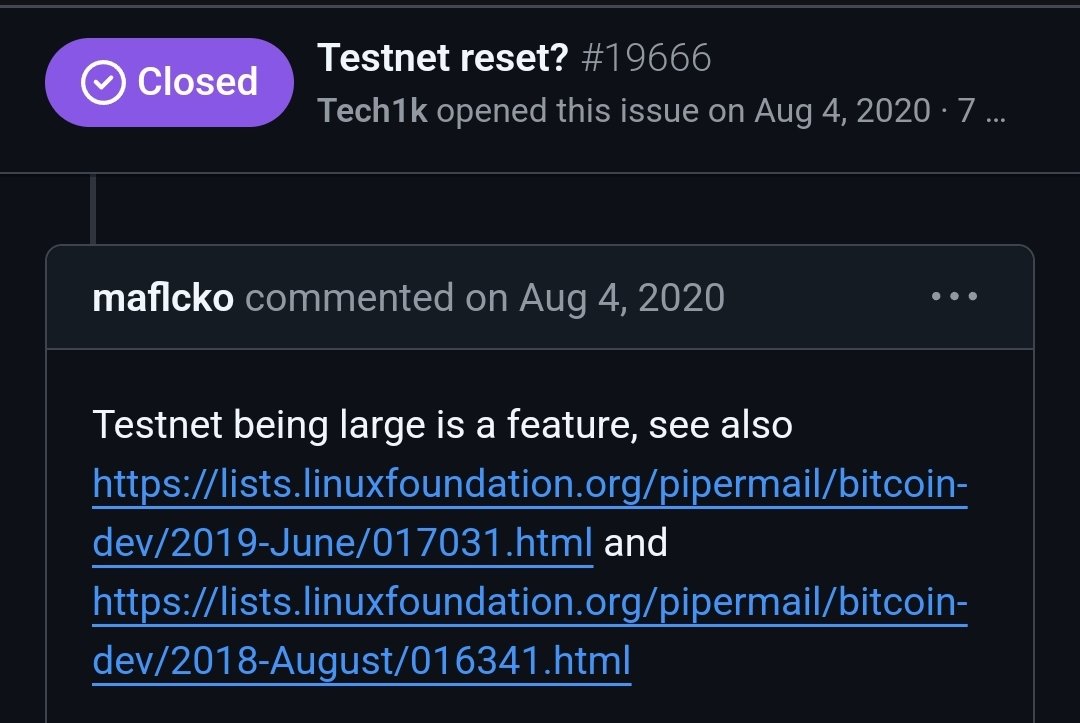 |
Bitcoin's Testnet3 has been running for over a decade, originally designed as a disposable playground for developers to test ideas without risking real money. Its coins, tBTC, were meant to be worthless, kept in check by the possibility of a reset. But that reset isn't happening -- and for reasons that go beyond technical preference. Core Dev Maflcko closed a reset proposal in 2020, arguing that "Testnet being large is a feature," a stance backed by discussions on the bitcoin-dev mailing list from 2019 and 2018. Meanwhile, Testnet3's decentralization, longevity, and the unexpected rise of markets and airdrops have given tBTC real-world value, locking it into a new reality. Here's why the reset is off the table and what's at stake. |
The Core Devs' Reasoning: Size Matters
When Tech1k opened issue #19666 on August 4, 2020, proposing a Testnet3 reset, Maflcko shut it down the same day. His comment was short but firm: a large testnet mimics the mainnet's complexity, making it a better testing ground. The linked mailing list threads from 2019 and 2018 elaborate on this, suggesting that resetting would strip Testnet3 of its real-world simulation capabilities -- think transaction volume, network stress, and miner behavior. A small, fresh testnet couldn't replicate that. It's a solid argument for developers who need a rugged environment, but it sidesteps what Testnet3's size and age have unleashed.Decentralization: Too Sprawling to Uproot
Ten-plus years of operation have turned Testnet3 into one of the oldest proof-of-work chains still kicking. It's not just a sandbox anymore and resetting it isn't just a matter of flipping a switch. The community has skin in the game, and that distributed ownership makes coordination nearly impossible. Like Bitcoin itself, Testnet3's decentralization has made it resilient -- but also stubborn. It's too big, too scattered, and too entrenched to simply wipe clean.
Markets and Airdrops: Value Creeps In
Here's where things get wild: tBTC isn't worthless anymore. Markets have sprung up where people trade Testnet3 coins, and some projects are using them for airdrops, tying them to real-world incentives. This isn't what anyone planned. With only 586 tBTC left to mine and just 250,000 addresses holding over 1 tBTC, scarcity is fueling this shift. The value -- however small -- motivates miners and node operators to keep the network humming. It's a feedback loop: value drives participation, and participation cements Testnet3's survival. But this pivot blurs its purpose. A testnet with financial stakes isn't quite a testnet anymore -- it's starting to look like an altcoin that mimics bitcoin almost exactly, which would make it the next best digitally scarce PoW asset after BTC itself.Testnet3 isn't getting reset and this is because of its size is useful, its decentralization is unbreakable, and its newfound value keeps it alive. Maflcko and the core devs see this as a feature, not a flaw, but it's a double-edged sword. What started as a tool for breaking things has become too valuable to break. The challenge now is balancing its role as a testing ground with the risks and opportunities of its unintended worth. Testnet3's story isn't over -- it's just beginning a weirder, wilder chapter.
Back to Exchange
